1.What is Takayama Chasen?
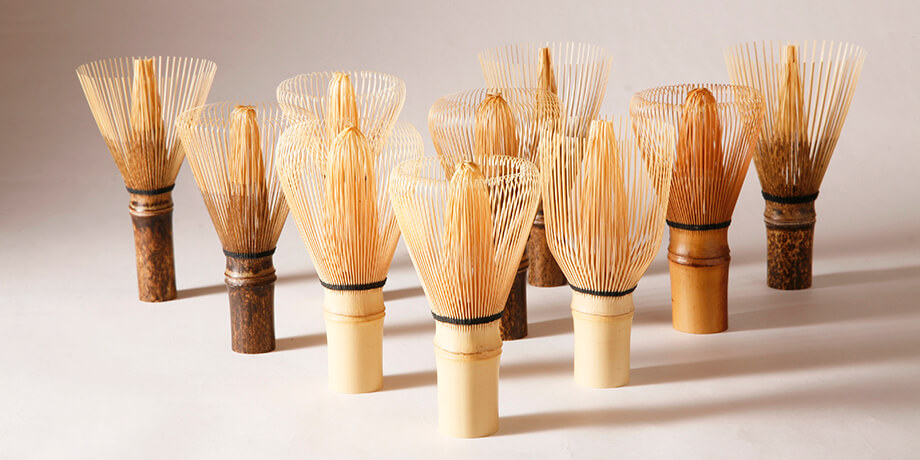
“Takayama Chasen” is a traditional craft that represents Nara.
Its production area is located in Takayama-cho, Ikoma City, in the northern part of Nara Prefecture.
Takayama Chasen, which is born in this area rich in nature, is not just a craft, but a “local industry” that produces more than 300,000 bottles a year (90% share of domestic production) and has more than 300 craftsmen.
The beginning of chasen
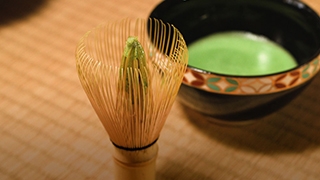
- How was the chasen born?
- Types of alpine chasen
- About the ingredients of Takayama Chasen
- How is Takayama Chasen made?
- We will introduce the process in 12 steps in detail, using a typical “Yajuhonritsu” chasen as an example.
- Mr. Sabun Kubo, the representative of Chasen-do Sabun
- Mr. Takefusa Kubo, a chasen master
- “Now” of Takayama Chasen
How was the chasen born?
Chasen is said to have been founded by Minbu no Jonyudou Sosetsu, who was the second son of the castle owner of Takayama (now Takayama-cho, Ikoma City) during the Muromachi period.
When Murata Juko, a priest of Nara Shomyoji and the ancestor of the tea ceremony, devised to enjoy the powdered tea leaves, he made a friendship with Chasen to create a tool for stirring the tea. In response to the request, Sosui seems to have worked hard to make the tea ceremony.
After that, the chasen made by Sono was offered to the observatory at the time of the emperor Gotsuchimikado’s visit to the Emperor Gotsuchimikado, and the idea and sophistication from the emperor were introduced. He was praised and received the inscription of “Takaho”.
The name “Takayama Chasen”, which continues to this day, is said to have been changed from the character “Takayama”, which is the hometown of Soto, after the inscription “Takaho” given by Emperor Gotomimon.
According to Takayama Chasen, Chasen is written as “Chasen” instead of “Chasen”.
It is said that the expression “chasen” means a tool for washing things.
Therefore, it seems that the character of Takayama “Chasen”, which represents a work of art, is used.
Types of alpine chasen
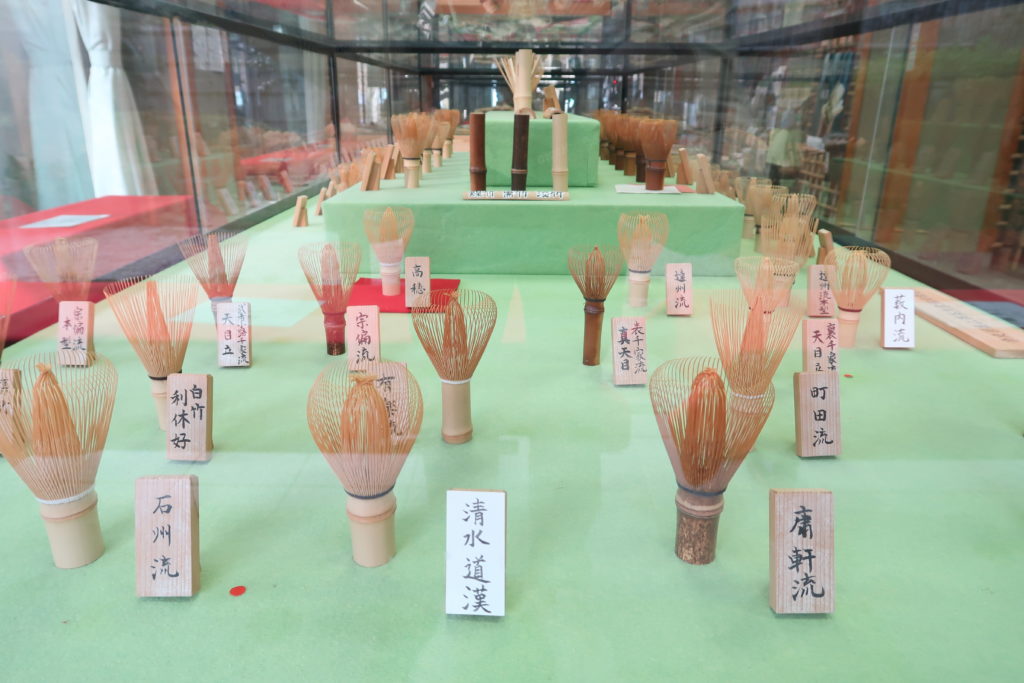
Chasen is distinguished by the type of bamboo, the shape of the spikes, the thickness and length of the bamboo, and the color of the thread.
Depending on the school, there are many types such as usage and number of ears, and there are various shapes.
“Firecracker chasen”: Mainly used for Omotesenke
“Kurotake Chasen”: Used for Mushakojisenke and Yamada Sect
“Shiratake Chasen”: Used for schools other than the above
“Aotake Chasen”: Used for the first pot, etc.
The shapes are determined by the school, and each is made with delicate and ingenious techniques, and there are about 120 types.
About the ingredients of Takayama Chasen
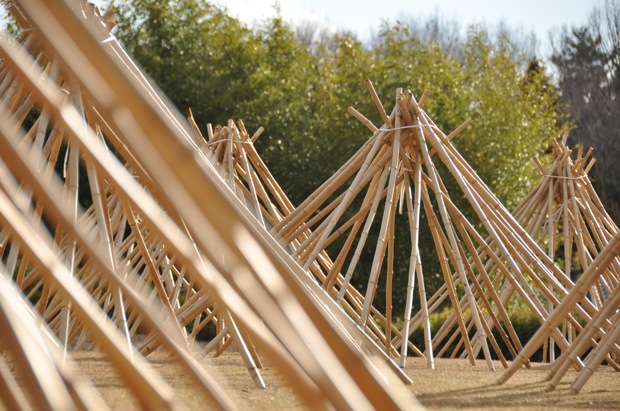
We use light bamboo (white bamboo), black bamboo, and firecracker.
Drain the good quality bamboo from the 2nd and 3rd grades. (Sun-dried fish is a winter tradition in the alpine region)
The firecrackers used mainly by the Omotesenke style are those naturally made in the thatched roofs of old private houses, but they are becoming more difficult to obtain year by year.
2.Working process
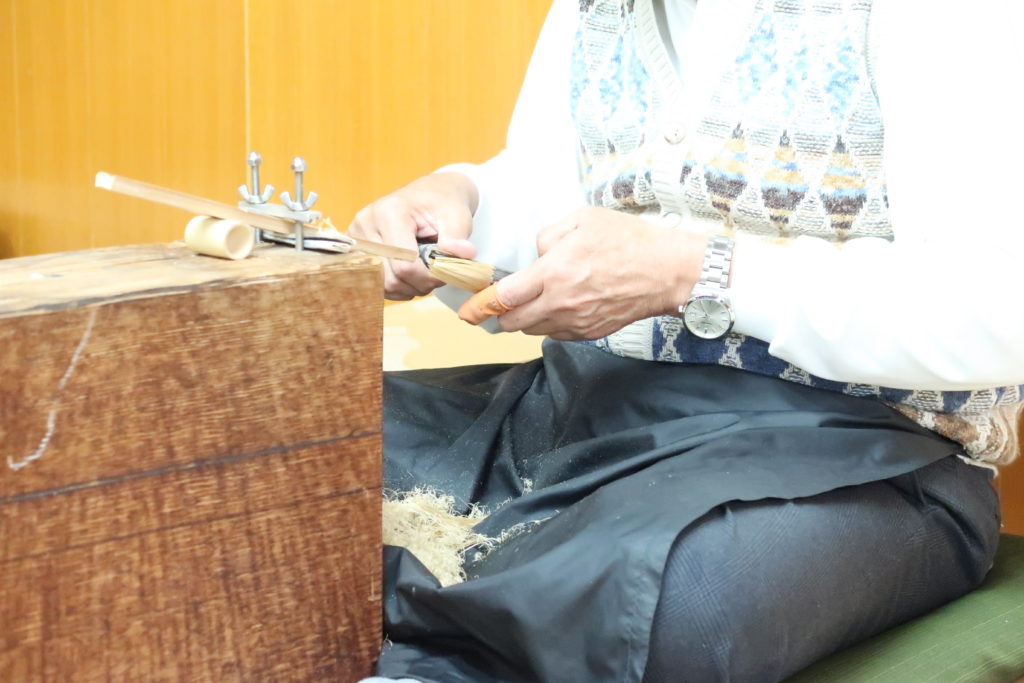
Inherited from ancestors-the “skill” of ”Isshisoden(一子相伝)”
How is Takayama Chasen made?
Bamboo, which is the raw material for chasen, is said to be good for the second and third graders of light bamboo, which is hard and sticky.
Bamboo cut out from October to December is boiled in hot water, carefully wiped with oil and dirt, and exposed to the cold sun for over a month.
1This “bamboo drying”, which is held from Monday to March, is a tradition of Chasen no Sato.
Bamboo that has been dried and left to rest for more than a year is cut into pieces according to the type of chasen, such as 3 inch 7 minutes and 3 inch 9 minutes.
Chasen
① Katagi
② Subdivision
③ Taste shaving
④ Chamfer
⑤ Second part
⑥ First part
⑦ Waist level
⑧ Finish
We will make it through all 8 processes.
Among them, “taste shaving” is the work of scraping the inner meat so that it becomes thinner toward the tip of the tip, and then squeezing the tip of the tip to draw a curve inward to shape it. It is the most difficult and skillful task in the whole process, as it can be compared to “it depends on the taste shaving”.
All chasen are made by hand by craftsmen and cannot be mechanized.
In addition, there are many types of chasen in a bite, and the type of bamboo, the shape of the chasen, and the number of ears differ depending on the school and purpose, so there are a wide variety of techniques that a chasen master should learn.
The work of making chasen is extremely delicate and requires high precision, so in order to acquire first-class skills, you must remember it in your body, not in your head.
It is said that it takes about 20 years of training to learn all the techniques.
It is called “fingertip art” because it is made mostly with a knife and fingertips, and is highly evaluated both inside and outside the country.

There are about 120 types of alpine chasen, each with different shapes, spikes, and materials.
We will introduce the process in 12 steps in detail, using a typical “Yajuhonritsu” chasen as an example.
① Katagi-Large Discount

② Katagi

③Katagi-Head

④Subdivision-head

⑤Subdivision-split

⑥Subdivision-split

⑦Taste shaving-shaving (horse mackerel)

⑧Taste-shaving

⑨Taste cutting-ironing

⑩Chamfer > Part 2

⑪Second part > First part

⑫Waist average > Tailoring

Adjust the height intervals of the inner and outer ears and the roots to adjust the overall shape and complete the Takayama Chasen.
3.Traditional craftsmen
Mr. Sabun Kubo, the representative of Chasen-do Sabun
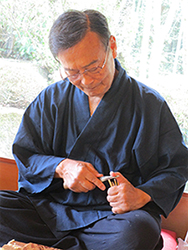
90% of the chasen produced annually in Japan is from Takayama, which boasts the top share. What is the reason for the flourishing production of chasen in Takayama?
Close to the source of good materials
First of all, I think that the environment was such that it was easy to procure high-quality bamboo.
Bamboo inhabits widely in Japan, but the bamboo on the Sea of Japan side bends due to the weight of snow, and the quality of bamboo in the coastal areas is not good due to the influence of the sea breeze.
In addition, it is said that excessively fertile soil is not suitable for growing bamboo with the optimum strength as a material for chasen.
In that respect, bamboo grown in the mountains in the inland area of the Kinki region has long been said to be the most suitable material for chasen, and Takayama was geographically superior in collecting good wood.
Close to the place of consumption
Since Sen no Rikyu completed it as “Wabi-cha”, the tea ceremony has become popular with many people, especially in Kyoto and Osaka, and the demand for chasen has increased significantly accordingly.
Alpine here is close to these large consumption areas, and it was a suitable land as a supply base for chasen.
The technology has been protected and passed down in the Ichiko Soden
Another important factor is that the production technology of Takayama Chasen has been preserved and passed down in this area through the Ichiko Soden.
Chasen has been working mainly at night for a long time.
In the daytime, I do other work such as bamboo picking, and I do my main business of making chasen in the middle of the night when everyone sleeps.
Working in the silence of the night not only stabilizes your mind and keeps you focused, but also reduces the risk of technology leaks to other companies.
In short, it is said that it was wisdom to protect Takayama’s secret technology.
“Thoughts” for chasen
One of my favorite words is “If you do it, you have to do it, you can’t do anything.”
As I mentioned earlier, the environment surrounding chasen making is harsh.
However, the situation cannot be improved just by doing nothing here and squeezing hands.
The tea ceremony industry such as the family and the tea whisk industry will bring together their wisdom and work together to sow new seeds in various places.
Then, I believe that the time will come when the flowers will bloom.
I would like to continue to do my best for the further development of tea ceremony and chasen making, which are the representative cultures of Japan.
Mr. Takefusa Kubo, a chasen master
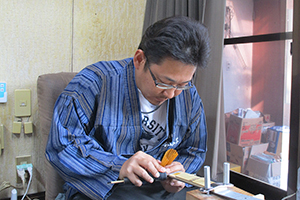
Takefusa Kubo entered this world with the desire to keep making chasen, which has been passed down from generation to generation.
It’s been 15 years since I entered the world of chasen, but Kubo is still the youngest.
If it is a Takayama Chasen production center association, 8 of the 20 members of the Takayama Chasen Production Cooperative are young craftsmen who are active as youth clubs.
The shortage of successors is an issue in the production areas of traditional crafts,
but the shortage of successors is also a major issue here in the production areas of Takayama Chasen.
There are about 8 chasen processes, and it takes 2 to 3 years to master one process, and 10 to 20 years to be able to produce from the beginning to the end.
There was also talk of raising craftsmen in the union.
It seems that it is often difficult, but the young craftsmen of the union are on good terms, and they are responding by teaching each other the secret techniques of each family, which was previously hidden from the gate.
Recently, we have introduced colorful chasen such as colored thread chasen (usually black thread is used for colored thread) at events such as SNS and department stores, and it is gaining popularity.
When it becomes popular, it is necessary to increase the production volume, but if you rely on outsourcing for the part that the family can not handle, it will be difficult to thoroughly control the quality, and it is not easy to increase the production volume.
Even if you want to increase production, you have the dilemma of having no manpower and few high-quality bamboo raw materials, but “I’m happy to see bamboo becoming a chasen” and “being involved in tea ceremony culture.” I’m proud of it, and I want to continue making the same products that will never change. “
4.Initiatives
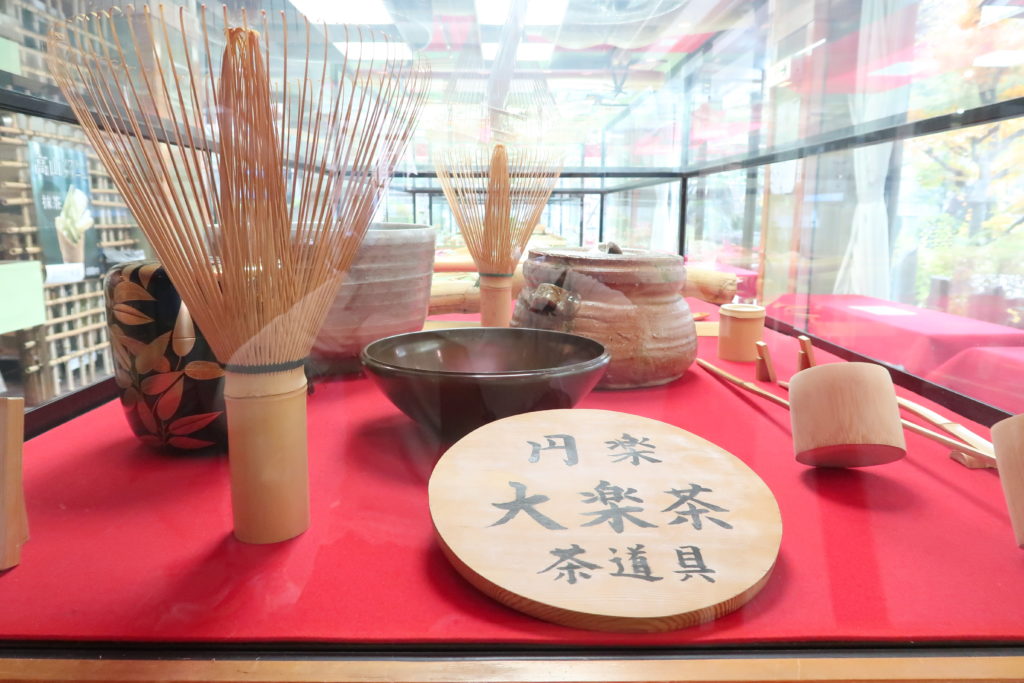
“Now” of Takayama Chasen
About the current state of tea whisk making as an industry.
Currently, there are more than 20 workshops here in Takayama, and more than 300 craftsmen and in-house workers are involved in the production of chasen.
Although the production volume has decreased compared to before, it still produces 300,000 chasen per year, accounting for more than 90% of the domestic market share, and the chasen is not just a traditional craft, but an “industry”. It can be said that it was established as.
I think one of the reasons why chasen has continued to be an “industry” is that it is a “consumable” as well as a necessity for chasen and tea ceremony.
Tea bowls and chagama can be used for a relatively long time, but it is said that the life of a chasen is about one year, even if you take two cups of tea a day.
In other words, as long as the tea ceremony exists in this world, the demand for chasen will continue to arise.
However, if you live comfortably in it, I think it is important to continue various efforts to further develop chasen making as an industry.

Difficulties in maintaining tradition -Influx of cheap overseas products and ever-decreasing demand -
It seems that you often had a hard time keeping the tradition that has been passed down for a long time and at the same time continuing and developing “Takayama Chasen” as an industry.
The production of Takayama chasen peaked around 1970, when the Osaka Expo was held.
At that time, Japan was in the “100 million total middle class society”, and it was widely accepted that women enjoyed tea flower arrangement as a bride.
Therefore, the chasen, which is a must-have item for Sado, sold like a fly.
At that time, nearly 2 million chasen were sold annually in Japan, and nearly 50 workshops were involved in the production in this area.
The tradition and high quality of Takayama Chasen were evaluated, and in 1975, it was designated as a traditional craft by the Ministry of International Trade and Industry (at that time) so that the “Takayama Chasen” brand would be recognized throughout Japan. became.
However, from the 1980s, many cheap chasen made overseas began to appear in Japan, and Takayama chasen, which is carefully made one by one with skillful techniques, became incomparable in terms of price.
Moreover, it was the tea whisk trader here in Takayama who provided technical guidance overseas and served as an import window.
In addition, some undeliverable vendors sell imported products under the name of Takayama.
We, the chasen masters, have gathered together to protect the Takayama chasen brand and established a union (Takayama Chasen Production Cooperative, Nara Prefecture).
The union held discussions day and night about what the future chasen industry should be, and finally confirmed that we were particular about Takayama chasen made with secret technology and would not handle overseas products.
However, even after that, the market erosion by overseas products did not stop, and fake brand products did not easily eradicate.
In retrospect, instead of having Takayama act as an import window and accepting overseas products, I think it would have been better to choose a means of distinguishing from Takayama Chasen and controlling the market. There is also.
It may have responded to a wide range of demand, such as Takayama products as luxury products for experts and low-priced products (renkahin) for beginners, and it was possible to prevent fraudulent activities such as fake brand products. maybe.
Then, in the 1990s, due to the effects of the recession and the social advancement of women, the economic and time margin for people’s hobbies and lessons gradually decreased, and the tea ceremony population and demand for chasen began to decline. I did.。
Recently, the annual sales of chasen have fallen below 1 million (300,000 to 400,000 for Uchikoku), which is a completely different situation from the time when it was on the rise.
No matter how much you keep the tradition and make good things, if there are no scenes where you can use them, you will not have any children.
We, the chasen masters, have come to have a great sense of crisis.

Always sow new “seed” to continue and develop as an industry
Is there any good idea to break through the current situation where demand continues to shrink?
Proposing new ways of using and expanding the base The important issue that we should tackle from now on is how to get people who have never had a chance to come into contact with tea ceremony and chasen to come into contact with chasen and be interested in it. I think it’s about getting it.
To that end, we are making efforts to incorporate a new sense into the making of chasen.
As one of the efforts, we recently devised a muddler type chasen with a longer handle than the original specifications.
In addition to being more stylish in appearance, the long handle makes the tip of the tip move more, making it easy to use even for those who are not accustomed to handling chasen, which has been well received.
I have proposed this and a mug as a set for tea making, or when making foam milk to put on cappuccino, as a new style of using ty line for cafes etc. I will.
Another is that we pack chasen, chasen, chashaku, etc. in a drawstring bag and sell it as a so-called beginner’s or portable set.
We hope that by organizing the tea utensils in a form that is easy to carry around, it will be an opportunity for people to enjoy tea even in different scenes such as outdoors.
Before entering the tea ceremony, it is important for you to enjoy tea playfully, and for that purpose, we are thinking about whether we can sell it for less than 10,000 yen.
If we want to make Tsu Aizumi’s honesty widely known and expand the base of demand, we must not continue to make the same products and sell them in the same way as before.
While preserving tradition, I would like to continue working to integrate new ideas into it and create opportunities for younger generations to pick up chasen.
Grasp overseas demand and expand sales channels
Recently, inquiries from overseas such as the United States, Canada, Italy, and China have increased.
Many people are interested in tea ceremony and chasen because of their “longing for Japanese culture”, and some customers want it as an ornamental work of art as well as for actually making tea.
At the moment, the lot is not so big, but as a market that has the potential to develop in the future, I would like to consider a method of promoting chasen overseas.
Source: “Ministry of Finance Kinki Finance Bureau Nara Finance Office” Reference
資料:「財務省近畿財務局奈良財務事務所」参考
Impressions

500 years of history, Ichiko Soden technology, tea ceremony taste, prosperity as an industry, the flow of the times, the future …
There is no industry in history that continues to grow.
How do you maintain and evolve the tradition while riding the waves when you are on the rise?
Do you find a new way steadily without being bound by the conventional concept when it is in a downturn?
What you have to do changes from time to time.
Those who were able to survive the rough seas are truly the successors of traditional crafts and traditional crafts.
Even for us ordinary people, when things go well, we move forward with a ton ton of beats, but only when that momentum is lost, we are stood on the edge of the cliff.
As the path I have believed in and pursued is fading, I think that many people are wondering how to live their lives in the future. In such a case, I think that “traditional crafts” and “traditional craftsmen” can give us a hint as much as possible.
No matter how bad it may be, if you have something to aim for, it is important to continue to work honestly.
Even if you don’t have what you want to aim for, think that you have the opportunity to give yourself some opportunity in front of you, and be honest with it.
To pass on what you have built up to future generations and pass on the wisdom to make it even better.
It felt like a mission given to us in the future.
I also want to continue to be a world where future generations can provide an environment where they can grow even more than they do now.
Next time preview
Please read to the end, thank you (^^) /
Next time, I would like to post about ” Nara Fude ”.
Let’s have a good trip!
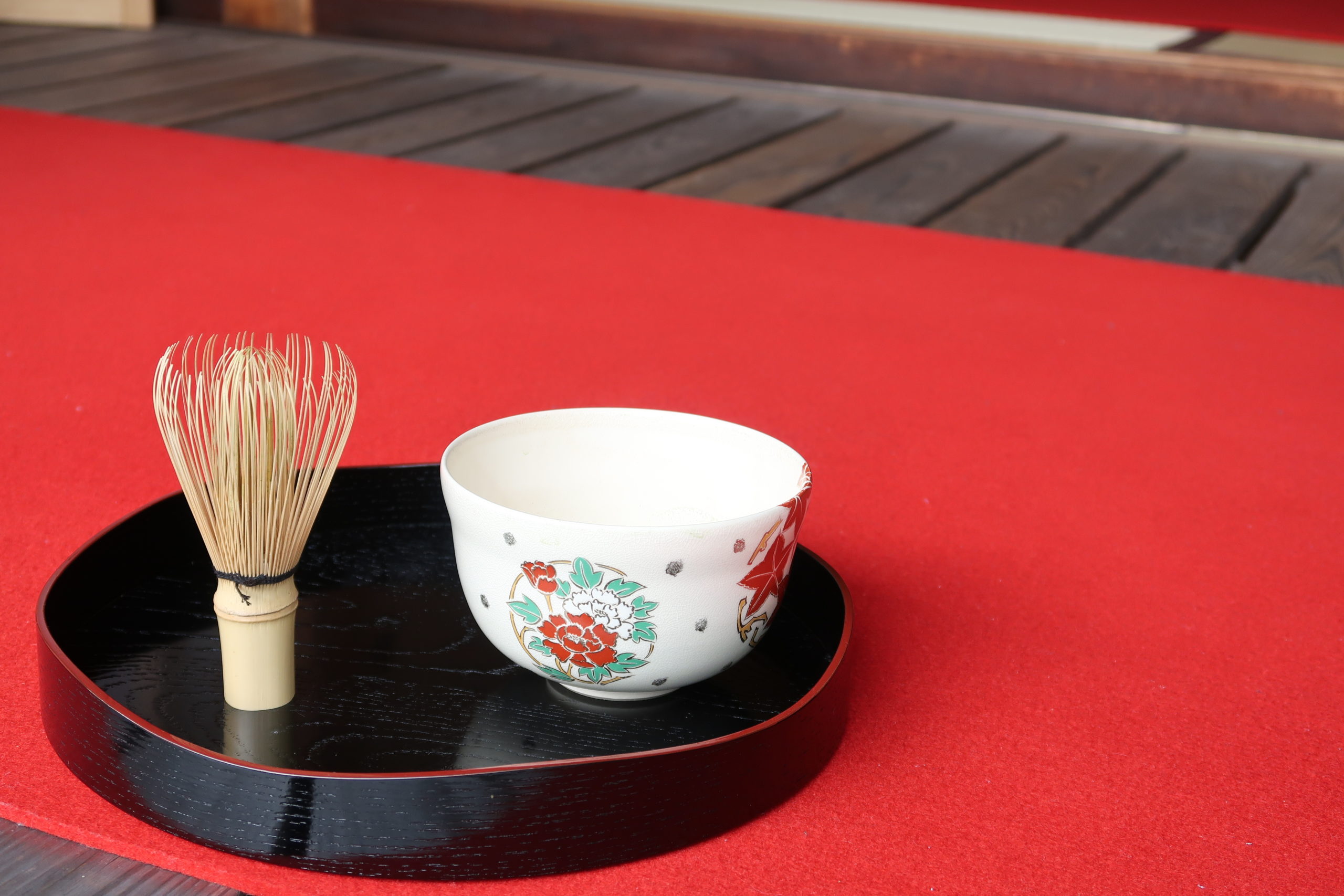


コメント